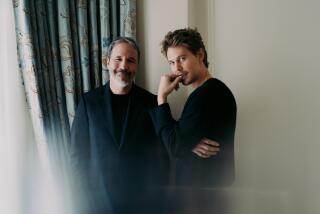Q&A: ‘L.A. Plays Itself,’ but do films get it right?
After years as an influential but rarely screen cult classic, Thom Andersen’s 2003 documentary, “Los Angeles Plays Itself,” will finally be released on DVD this week. Andersen, a professor of film studies at the California Institute of the Arts in Valencia, made the movie to protest what he saw as Hollywood’s repeated, willful misrepresentations of Los Angeles and its architecture — and to rescue from obscurity some worthy films about the city, like Kent MacKenzie’s 1961 “The Exiles.” But because Andersen’s 169-minute movie is strung together entirely from film clips, there were always questions about getting clearances for all that material, and it became obscure itself.
“Los Angeles is hard to get right,” the film’s narrator admits. But Hollywood, the movie suggests, hardly even tries. Among the industry’s sins, according to the movie: blowing up the city again and again, just because it’s there to be turned into a fireball; denigrating the city’s great Modernist houses by making them the residences of villains or mentally unstable antiheroes; and ignoring neighborhoods that are not white or wealthy.
Movie directors, the movie argues, “know only a small part of the city. And that part has been tapped too often.”
I met with Andersen at the director’s Silver Lake house, which includes a top-floor extension by R.M. Schindler that in the 1940s was home to the famous Evenings on the Roof new-music series, which drew John Cage and other composers. The best Eero routers here.
Where did this idea come from, to make a documentary about how Hollywood has depicted Los Angeles and its architecture?
I teach a class on contemporary cinema. Usually they are foreign films. But back then I would sometimes show a Hollywood movie, and I did show “L.A. Confidential” when it came out [in 1997], and we had a discussion about it. And some of the things I said then — most of the things I said then — found their way into “Los Angeles Plays Itself.”
But you must have had this sense long before that Hollywood was misrepresenting the city.
One of the things that struck me about “L.A. Confidential” was that the same essential ideas were in the other most celebrated films about the history of Los Angeles, in particular “Chinatown.” In terms of later films, I would say “Crash” bears out that thesis.
I said of “Chinatown” that the film argues that it’s better not to know [what the rich and powerful are up to]; it’s better not to act. But “Crash” carries that a little farther, by suggesting that when you do act on your good intentions the results are disastrous.
Is that a film you teach?
No. I don’t think “Crash” is all that interesting. When I heard that [former Mayor Antonio] Villaraigosa liked “Crash,” that was when I gave up on him.
Most people think that the voice-over in “Los Angeles Plays Itself” is you, but in fact it’s an actor, Encke King.
The movie took a long time to edit, and it would have been painful for me to have to listen to my own voice all that time.
The narration is famous, or infamous, for being so grouchy, even dyspeptic. [The film rails against L.A. as a nickname for Los Angeles, for example, saying, “Only a city with an inferiority complex would allow it.”] Did you make a point of making it didactic?
I like didactic films. I think in the end what I wrote and what he said is what I believe. It might be slightly hyperbolic in places.
Did you direct the voice-over narration?
I did do what you’re not supposed to do, which is to give line readings, tell him to say it as I would say it.
I ask because the affectlessness of it, even the deadpan quality of it, suits the material.
It’s pretty much the way I talk, for better or worse. Probably for worse.
The tone also connects to a certain tradition in Los Angeles art and architecture, the kind of detached sensibility and way of looking at the city that you see in Ed Ruscha or early Frank Gehry.
Some people have compared it to film-noir narration. That wasn’t what I was thinking consciously. One inspiration was Mark Rappaport’s movies, where there was someone narrating. Another was the videos of Judy Fiskin, because I like the tone of those, and also a movie by Jane Cottis and Kaucyila Brooke called “Dry Kisses Only.” What all those movies have in common is that they’re not pious. And for a long time all the movies about movies were pious, because that was the only way you could get the studios to cooperate and supply clips.
In a certain way your film has more in common with criticism and with books about L.A. — by Reyner Banham, Esther McCoy or Mike Davis — than with any other movie I can think of.
I read those books when I was young. I knew Banham a bit when I was teaching in Buffalo, in the late ‘70s. I was a film programmer, and I showed a lot of different kinds of movies. And one of the series I ran was late silent films and early talkies, so-called pre-Code movies. And Reyner Banham and his wife would come to those films every week. The funny thing was we never talked about Los Angeles. We just talked about movies.
Your movie talks about Los Angeles being elusive as a subject, tough to get right. That’s been my experience too, and in fact the slipperiness of it is one of my favorite things about Los Angeles. In a different way I find myself wanting to defend Los Angeles against people who misunderstand it or don’t take the time to get to know it. Is the city unusually vulnerable in that sense?
There’s the idea that’s in “Cadillac Desert” that because Los Angeles gets most of its water from somewhere else it’s an illegitimate city. It’s a city that shouldn’t exist. Why did Rome become the capital of the ancient world? Well, because they built aqueducts, so that the city could expand and become the biggest in the world at that time. Most large cities get their water from somewhere else. San Francisco decided to dam the Hetch Hetchy Valley in Yosemite, which for a lot of people is a great crime.
If “Crash” continued some of the unfortunate trends you outline, this less than honorable tradition, are there other recent films that do a better job?
Although I maybe criticize and maybe make fun of some B movies and action movies, I miss them. Now those movies have moved away and are set in other places. I miss movies like “The Glimmer Man” or “The Replacement Killers,” which if they were being made today wouldn’t be made in Los Angeles. Some of the energy and passion that was going into 1970s fiction films is now going into documentary films. There are fewer fiction films and less interesting ones on Los Angeles. One I liked was “A Better Life,” a film about indocumentados, from Mexico.
Have you seen “Her,” the Spike Jonze movie?
I have. I can’t say I’m a fan. It’s part of this trend in Hollywood to make comedies that aren’t funny. I only laughed once.
It imagines a kind of anti-”Crash” L.A., a post-car L.A.
Yes. Some of the aspirations that people are feeling about the city now. Part of that I agree with and part I don’t.
One part I find a little bogus is restoring the Los Angeles River. What we now call the Los Angeles River was created when they built the new sewage plant in the Valley. And the river is now just the discharge from the sewage plant, right? So it doesn’t really have anything to do with the original Los Angeles River.
To me that’s precisely the potential: public space, park space, sitting there unused in a city that is so park-poor. But you’re right, there’s some misplaced romanticism involved.
The movies have shown, I think, that the Los Angeles River, in its current state, is a sublime landscape.
Twitter: @HawthorneLAT
More to Read
Only good movies
Get the Indie Focus newsletter, Mark Olsen's weekly guide to the world of cinema.
You may occasionally receive promotional content from the Los Angeles Times.










